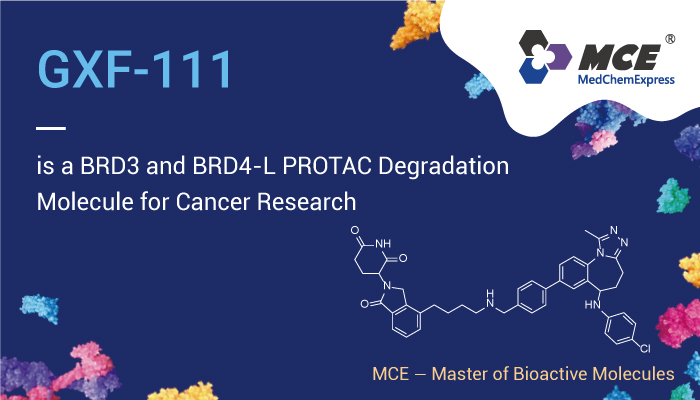PROTACs are bi-functional molecules, capable of concurrently binding to target proteins of interest and the subunits of E3 ligases, such as Cereblon, VHL, and MDM2, among others. In short, Cooperative interactions of three components comprising a target protein, an E3, and a PROTAC molecule, lead to ubiquitination and subsequent degradation of target proteins by proteasome machinery. So, targeted degradation of BET family proteins BRD2/3/4 or only BRD4 with PROTAC molecules has been a promising strategy for the treatment of human cancer.
In this article, we introduce GXF-111, a BRD3 and BRD4-L PROTAC degradation agent. Studies show that selective degradation of cellular BRD3 and BRD4-L elicits strong antitumor activities in selected human cancer cell lines and a mouse xenograft model.

GXF-111 is a BRD3 and BRD4-L PROTAC degradation molecule for cancer research.
GXF-111 is a BRD3 and BRD4-L PROTAC Degradation Molecule. Firstly, It can promote selective degradation of cellular BRD3 and BRD4-L, but not BRD2 or BRD4-S, in a panel of six cancer cell lines. GXF-111 has binding affinities for BRD3 BD1 and BRD3 BD2 with Ki values of 11.97 nM and 2.35 nM, respectively. Secondly, GXF-111 has cellular activities in MV4-11 and MM.1 S cell lines with IC50 values of 6.31 nM and 95.2 nM, respectively. In vitro, GXF-111 (2, 10 nM; 24 h) has potent cell growth inhibition activities for the degradation of BET family proteins in MM.1 S cells. Furthermore, GXF-111 (4 days) has anti-proliferative activity in 7 human cancer cell lines with IC50 values ranging from 6.31 nM to 17.25 μM.
Reference:
[1] Yan Z, et al. Eur J Med Chem. 2023;254:115381.